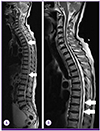1. Gilden DH, Kleinschmidt-DeMasters BK, LaGuardia JJ, Mahalingam R, Cohrs RJ. Neurologic complications of the reactivation of varicella-zoster virus. N Engl J Med. 2000; 342:635–645.

2. Gilden D, Nagel MA, Cohrs RJ, Mahalingam R. The variegate neurological manifestations of varicella zoster virus infection. Curr Neurol Neurosci Rep. 2013; 13:374.

3. Amlie-Lefond C, Jubelt B. Neurologic manifestations of varicella zoster virus infections. Curr Neurol Neurosci Rep. 2009; 9:430–434.

4. Hung CH, Chang KH, Kuo HC, Huang CC, Liao MF, Tsai YT, Ro LS. Features of varicella zoster virus myelitis and dependence on immune status. J Neurol Sci. 2012; 318:19–24.

5. Baik JS, Kim WC, Heo JH, Zheng HY. Recurrent herpes zoster myelitis. J Korean Med Sci. 1997; 12:360–363.

6. Han MK, Lee SS, Han SH. Herper zoster myelitis confirmed by detection of varicell-zoster virus DNA using the polymerase chain reaction. J Korean Neurol Assoc. 1996; 14:1067–1071.
7. Hwang YM, Lee BI, Chung JW, Ahn JH, Kim KW, Kim DI. A case of herpes zoster myelitis. J Korean Neurol Assoc. 1988; 6:272–277.
8. Yang IS, Lim GD, Shin SS. A case of herpes zoster myelitis: a case report. J Korean Pain Soc. 1997; 10:266–269.
9. Yi H, Lee Y, Shin HY, Kim SM. Varicella zoster viral myelitis in immunocompetent patient. J Korean Neurol Assoc. 2014; 32:339–341.
10. Cohen JI. Clinical practice: Herpes zoster. N Engl J Med. 2013; 369:255–263.
11. Takahashi T, Tamura M, Miki K, Yamaguchi M, Kanno A, Nunomura S, Ra C, Tamiya T, Kamei S, Takasu T. Varicella zoster virus myelitis in two elderly patients: diagnostic value of nested polymerase chain reaction assay and antibody index for cerebrospinal fluid specimens. Case Rep Neurol. 2013; 5:81–90.

12. Lee CC, Wu JC, Huang WC, Shih YH, Cheng H. Herpes zoster cervical myelitis in a young adult. J Chin Med Assoc. 2010; 73:605–610.

13. de Silva SM, Mark AS, Gilden DH, Mahalingam R, Balish M, Sandbrink F, Houff S. Zoster myelitis: improvement with antiviral therapy in two cases. Neurology. 1996; 47:929–931.

14. Ong OL, Churchyard AC, New PW. The importance of early diagnosis of herpes zoster myelitis. Med J Aust. 2010; 193:546–547.

15. Outteryck O, Deramecourt V, Bombois S, Mackowiak-Cordoliani MA, Pasquier F. VZV-related myelitis: a pathophysiological hypothesis. Rev Neurol (Paris). 2007; 163:89–92.






 PDF
PDF ePub
ePub Citation
Citation Print
Print



 XML Download
XML Download